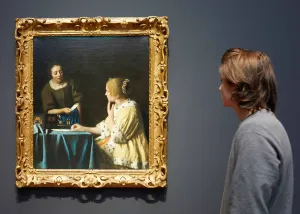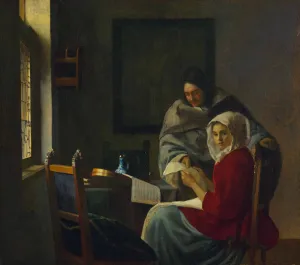Return of the Vermeers: New Insights on Three Masterworks
June 2, 2023
By Anna-Claire Stinebring, Anne L. Poulet Curatorial Fellow
The Frick’s three paintings by Vermeer return to the galleries at Frick Madison on June 15, 2023.
The Vermeers are back. Through the remainder of our temporary residency at Frick Madison, visitors can once again encounter Officer and Laughing Girl, Girl Interrupted at Her Music, and Mistress and Maid—The Frick Collection’s trio of remarkable paintings by the seventeenth-century Dutch artist Johannes Vermeer—together in one room. Freshly reinstalled after their presentation in the Rijksmuseum’s landmark Vermeer exhibition, our canvases by the “Sphinx of Delft” have divulged a few more secrets from their layered histories.
Lessons from Amsterdam
|
Left to right: Johannes Vermeer (Dutch, 1632–1675), Girl Interrupted at Her Music, ca. 1658–59. Oil on canvas, 15 1/2 x 17 1/2 in. (39.4 x 44.5 cm). Vermeer, Mistress and Maid, ca. 1666–67. Oil on canvas, 35 1/2 x 31 in. (90.2 x 78.7 cm). Vermeer, Officer and Laughing Girl, ca. 1657. Oil on canvas, 19 7/8 x 18 1/8 in. (50.5 x 46 cm). All works at The Frick Collection, New York. Photos: Joseph Coscia Jr.
|
||
The recent Amsterdam show offered an exceptional opportunity to contextualize the Frick works within the Delft artist’s career. Twenty-eight paintings by or attributed to Vermeer were on view, the most that one exhibition has ever shown from his surviving oeuvre of only around thirty-five pieces. The Frick’s loans—possible during the renovation and enhancement of our historic East 70th Street buildings—were key to securing the Rijksmuseum exhibition’s unprecedented scope. The show marked the first time that the three paintings left New York as a group since their acquisition in the early 1900s.

|

|
|
|
Left: Visitor viewing the Frick’s Mistress and Maid in Vermeer at the Rijksmuseum. Right: Visitors in the Vermeer galleries at the Rijksmuseum, featuring the Frick’s Officer and Laughing Girl and Mistress and Maid with the National Gallery of Ireland’s Woman Writing a Letter, with Her Maid. Photos courtesy of the Rijksmuseum/Henk Wildschut
|
||
In many ways, the reinstallation of the Vermeer paintings at Frick Madison represents a microcosm of central themes experienced by visitors to the Amsterdam exhibition. All three Frick paintings reveal Vermeer’s signature focus on domestic spaces, especially the activities and inner lives of women. Likewise, the thematic organization of the Vermeer show highlighted, for example, the role of music in suggesting an amorous relationship in Girl Interrupted at Her Music, or the evocation of the outside world with the arrival of a letter in Mistress and Maid.
|
Left: Detail of Mistress and Maid, showing carefully blended brushstrokes. Right: Detail of the wall map in Officer and Laughing Girl, with dabs of paint placed side by side. Photos: Joseph Coscia Jr.
|
||
The Frick canvases also demonstrate just how much Vermeer varied his painting style across his career, a clear lesson from the exhibition. Mistress and Maid is large-scale, with the brushstrokes carefully blended, while the smaller Officer and Laughing Girl is comprised of dabs of paint placed side by side. This latter approach is also identifiable in other breathtaking exhibition works such as The Milkmaid (Rijksmuseum) and Girl Reading a Letter at an Open Window (Gemäldegalerie Alte Meister, Dresden). It is a technique that some scholars have associated with Vermeer’s possible use of optical devices such as the camera obscura, a topic of ongoing and impassioned debate. The differences across the three paintings serve as a reminder that their intense degree of naturalism is entirely constructed by the artist, rather than representing a straightforward transcription of reality.
Pearls, Furs, Ceramics, and More
In Amsterdam, the Frick’s Mistress and Maid was a posterchild for the show—or, more specifically, details of the seated woman’s fur-lined coat and pearl earring. Echoes of this yellow coat, clearly a studio prop, appeared throughout the exhibition: in Young Woman with a Lute (The Metropolitan Museum of Art, New York); in Woman with a Pearl Necklace (Gemäldegalerie, Berlin); in A Lady Writing (National Gallery of Art, Washington, D.C.); and in The Love Letter (Rijksmuseum). A jacket made of yellow satin with white fur trim is listed in the 1676 inventory of movable goods in Vermeer’s home, drawn up just a few months after his death. As luxurious as this coat is meant to appear in the paintings, however, the lining was perhaps made of rabbit fur dyed to look like more expensive ermine.

Another evident studio prop, the large pearl in Mistress and Maid, was also likely fake. Frick Curator Aimee Ng elaborated on this important topic in “Vermeer’s Pearls,” a talk given as part of the Rijksmuseum’s Vermeer Symposium in late March. While stressing that Vermeer’s famous pearls are ultimately “neither real nor fake—they are just paint,” Ng reevaluated the artist’s renderings of these natural gems in the context of the brutal conditions in which pearl divers often worked. She also explored the centuries-old industry of making counterfeit pearls, with recipes evolving to include materials from powdered mother-of-pearl to egg whites and glass (sometimes enhanced with fish scales or even snail slime). You can learn more in an episode of the Frick’s Where in the World? series.
Ng’s presentation was in dialogue with other compelling investigations into the material world conjured by Vermeer. A talk by Boston University scholar Christina An took a closer look at the artist’s depictions of imported Asian porcelain, reassessing the presence of these sought-after luxury goods in Vermeer’s domestic interiors, including Girl Interrupted at Her Music.
Moreover, the Frick’s former Anne L. Poulet Curatorial Fellow Rozemarijn Landsman offered new research related to her recent publication, Vermeer’s Maps, which examines the significance of the detailed renderings of recognizable maps throughout Vermeer’s body of work. This phenomenon includes, notably, the prominent Map of Holland and West-Friesland by Balthasar van Berckenrode shown on the back wall in the Frick’s Officer and Laughing Girl and portrayed in two other paintings, all three united in the Rijksmuseum’s exhibition galleries.

Both the exhibition catalogue and a symposium talk by Judith Noorman, a University of Amsterdam professor who leads The Female Impact research project, brought renewed focus to a Delft woman named Maria de Knuijt. Her role in supporting Vermeer’s career as one of his main patrons (along with her husband, Pieter van Ruijven) has too often been overlooked, and it is very possible that the couple were the original owners of two of the three Frick paintings: Officer and Laughing Girl and Mistress and Maid.
Finally, the symposium offered new perspectives on the artist’s materials and technique, including significant changes made to compositions during the painting process. For example, Research Scientist Silvia Centeno and Paintings Conservator Dorothy Mahon of The Metropolitan Museum of Art shared insights into an ongoing project focused on several of The Met’s Vermeer canvases. Centeno and Mahon also recently made discoveries regarding the design and original appearance of the Frick’s Mistress and Maid. You can read more about these exciting findings in a past blog post.
Back on View in a New Light

Whether pensive or smiling, gazing outward or looking away, Vermeer’s figures keep many of their secrets close. Yet now is also an exciting moment for new conversations and research concerning the Frick’s important collection of paintings by the Delft master—ranging from how the works were made to how the paintings depict class or refer obliquely to Dutch colonialism. You can investigate some of the current dialogues through recent Frick publications such as Vermeer’s Maps as well as in blog posts, videos, and other content.
And, of course, we invite you to once again explore these questions directly in front of the works in the Vermeer room at Frick Madison. With extended close looking, subtle marvels emerge from the canvases, such as the bright contours of a folded letter or the glinting panes of an open window. Thick, white highlights form a humble apron hem, an opulent pearl earring, or the texture of a wall map bathed in sunlight. In these interiors, light becomes its own character in the unfolding dramas. They are narratives that viewers only glimpse as interlopers on the scenes, which, try as we might, are never fully revealed.





